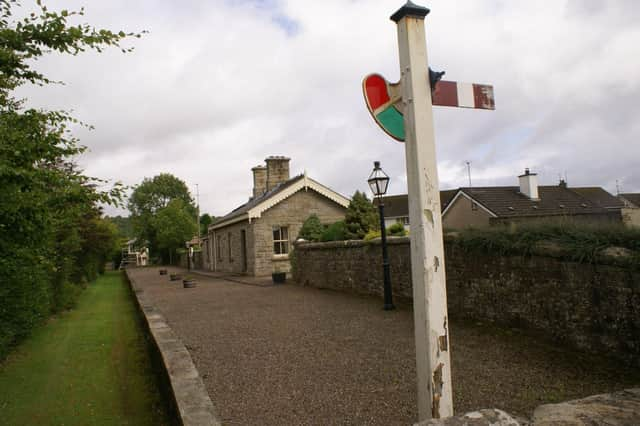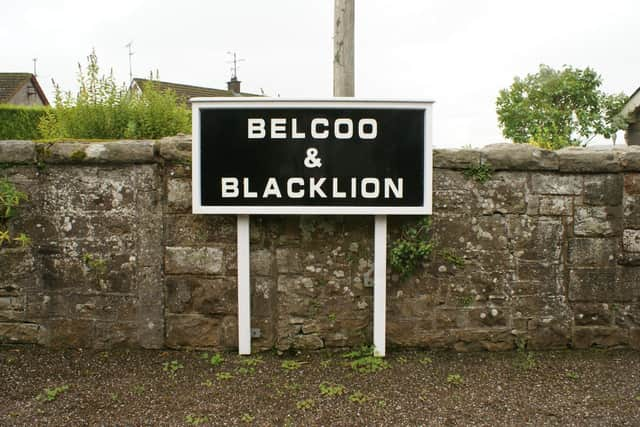Complex Customs and erstwhile border seizures that boggle the brain


Donated to Headhunters Railway Museum in Enniskillen by Arlene Little, it is packed with details of all sorts of goods and merchandise confiscated on the border from 1937 to 1945.
Last Friday’s page ended with an entry from the Register which itemised the seizure of “a dozen knickers, a horse and cart, a pint of jelly, a piano accordion and a rifle.”
Advertisement
Hide AdAdvertisement
Hide Ad“What did anyone crossing the border intend to do with all that?” the e-mailer quipped, and yes, the mind boggles.


(Readers are invited to forward any thoughts, ideas and/or suggestions to Roamer’s mailbox!)
But in the context of the enormous controversy around the Protocol, and during the on-going 100th anniversary of the establishment of the border, it’s enlightening, even endearing, to be reminded of Customs procedures in days of yore.
In seven intensely-packed columns of handwritten details across every two pages, the Register intricately described, categorised and cross referenced each confiscated item by its estimated value, time, date and location of seizure, offender’s name, customs official’s particulars, senior officer’s instructions, and the manner and date of disposal.
Advertisement
Hide AdAdvertisement
Hide AdAnd each and every item was allocated at least one long, complicated, reference number.
There’s a huge amount of inherent mystery and intrigue, not just ‘between the lines’ but amongst the often-lengthy additional comments and official annotations, though some of the handwriting is blotched and almost indecipherable.
The first entry was made on 2nd January 1937 when a ‘motor’ was stopped and the name of the offender was recorded as ‘unknown’.
The seized goods were described as “eight stone of maize meal. One Raleigh bicycle. One gent’s overcoat (old).”
Advertisement
Hide AdAdvertisement
Hide AdA senior officer wrote an instruction in blue ink - “the goods in question are to be retained as a seizure. No further action necessary.”
Another instruction was added in red ink on 15 April 1937, over three months after the initial seizure - “the meal to be sold locally and the coat destroyed but offers for the bicycle are to be submitted for approval.”
Yet another month later, on 11 May 1937, a further entry was added in the column headed ‘Manner and Date of Disposal’ - “eight stone of maize meal was sold in Tullyhommon for five shillings.”
(In case some folk don’t know, Pettigo is divided by the border and the part of the town in Northern Ireland is called Tullyhommon!)
Advertisement
Hide AdAdvertisement
Hide AdThe seizure was allocated a complicated receipt with a dated code number - CF305No. B677566 11.5.37 - and signed by another customs official on 28 May when it was
also noted that “the bicycle was sold for one pound. The coat was destroyed by burning in the presence of a customs official.”
The entire entry was completed and signed off on 16 August 1937.
It began with eight stones (weight) of animal feed, a bicycle and an old coat, seized on the border from an unnamed motorist by a Customs official and a Garda officer.
Advertisement
Hide AdAdvertisement
Hide AdThe proceedings thereafter took almost eight months and whereas the number of officials involved can only be guessed at, there were over eight pens, pencils and styles of handwriting used in the Register, suggesting at least half a dozen folk involved in the whole process.
All that chronicled just one person crossing the border, in one direction, noted in one document at just one border crossing.
And to add to the complexity - seizures and confiscations were made on railway station platforms, in Post Offices, on main roads, and by patrols anywhere on the border, never mind ports and airports!
The mind boggles even more when contemplating customs procedures in days of yore in Belcoo, County Fermanagh, and Blacklion, County Cavan.
Advertisement
Hide AdAdvertisement
Hide AdSeparated merely by a narrow river (the Irish Béal Cú means a narrow stretch of water) the train station was unique in serving two towns located in two different countries.
I’ll leave that conundrum for another day and return to the old Register for some more seizures!
On 5 March 1937 a border patrol consisting of two customs officials and two Garda officers stopped a Pettigo resident and confiscated “two jars of herring sandwich-spread, one tin of Ovaltine, a lady’s handkerchief and two and a quarter ounces of cigarettes.”
Almost two months later at the end of April the Customs and Excise Commissioners “decided not to institute proceedings in this case in payment of the sum of £5 as a compromise fine.”
Advertisement
Hide AdAdvertisement
Hide AdAt the end of May the goods were allocated a lengthy reference number - CE653/3160/3Y - and were “forwarded to the Office of the State Warehouse in Galway.”
They endured a happier ending than half a stone of flour (reference number CE653/3151/3Y) confiscated on the previous day from a 13½-year-old local girl.
“The flour in question is to be retained as a seizure” a senior Customs official wrote in the Register on 20 March 1937 (in threateningly bright-red ink!) adding “an effort is to be made to dispose of it in Northern Ireland. If this is not possible, it is to be destroyed locally.”
Almost a fortnight later, on 2 April, another Customs Official noted in the Register - “goods (½ stone of flour) destroyed by dumping in local river.”
A message from the Editor:
Advertisement
Hide AdAdvertisement
Hide AdThank you for reading this story on our website. While I have your attention, I also have an important request to make of you.
In order for us to continue to provide high quality and trusted local news on this free-to-read site, I am asking you to also please purchase a copy of our newspaper whenever you are able to do so.
Our journalists are highly trained and our content is independently regulated by IPSO to some of the most rigorous standards in the world. But being your eyes and ears comes at a price. So we need your support more than ever to buy our newspapers during this crisis.
With the coronavirus lockdown having a major impact on many of our local valued advertisers - and consequently the advertising that we receive - we are more reliant than ever on you helping us to provide you with news and information by buying a copy of our newspaper when you can safely.
Advertisement
Hide AdAdvertisement
Hide AdYou can also enjoy unlimited access to the best news from across Northern Ireland and the UK by subscribing to newsletter.co.uk
With a digital subscription, you can read more than five articles, see fewer ads, enjoy faster load times, and get access to exclusive newsletters and content. Visit https://www.newsletter.co.uk/subscriptions now to sign up.
Thank you